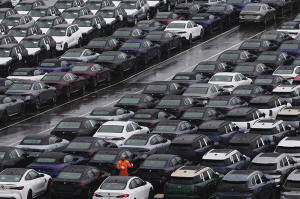Dozens of countries with no deals face new tariffs as trade deadline
looms
[August 01, 2025] By
CHRISTOPHER RUGABER
WASHINGTON (AP) — Numerous countries around the world are facing the
prospect of new tariffs on their exports to the United States on Aug. 7,
a potential blow to the global economy, because they haven't yet reached
a trade deal with the Trump administration.
President Donald Trump had threatened to impose the tariffs on Aug. 1
but delayed the deadline by a week just hours before they were supposed
to take effect.
Some of the United States' biggest trading partners have reached
agreements, or at least the outlines of one, including the European
Union, the United Kingdom, and Japan. Even so, those countries face much
higher tariffs than were in effect before Trump took office. And other
large trading partners — most notably China and Mexico — received an
extension to keep negotiating, but they will likely end up paying more.
Trump intends the duties to bring back manufacturing to the United
States, while also forcing other countries to reduce their trade
barriers to U.S. exports. Trump argues that foreign exporters will pay
the cost of the tariffs, but so far economists have found that most are
being paid by U.S. companies. And measures of U.S. inflation have
started to tick higher as prices of imported goods, such as furniture,
appliances, and toys rise.
Countries without an agreement face duties ranging between 10% and 40%,
according to Trump's executive order signed on Thursday. That includes
large economies such as Taiwan and India, as well as many smaller
countries like South Africa, Sri Lanka, Bangladesh, and even tiny
Lesotho.

Will the deadline hold this time?
Trump’s original April 2 “Liberation Day” announcement threatened to
impose import taxes of up to 50% on nearly 60 countries and economies,
including the 27-nation European Union. Those duties, originally
scheduled for April 9, were then postponed twice, first to July 9 and
then Aug. 1.
On Wednesday, Trump said on his social media platform Truth Social, “THE
AUGUST FIRST DEADLINE IS THE AUGUST FIRST DEADLINE — IT STANDS STRONG,
AND WILL NOT BE EXTENDED.”
As of Thursday afternoon, White House representatives — and Trump
himself — had insisted that no more delays were possible.
But when Trump signed the order Thursday night imposing new tariffs on
68 countries and the European Union, the start date of the punishing
import taxes was pushed back seven days so that the tariff schedule
could be updated. The change — while potentially welcome news to
countries that had not yet reached a deal with the U.S. — injected a new
dose of uncertainty for consumers and businesses still wondering what’s
going to happen and when.
Which countries have a trade agreement?
In a flurry of last minute deal-making, the Trump has been announcing
agreements as late as Thursday, but they are largely short on details.
On Thursday, the U.S. and Pakistan reached a trade agreement expected to
allow Washington to help develop Pakistan’s largely untapped oil
reserves and lower tariffs for the South Asian country.
And on Wednesday, Trump announced a deal with South Korea that would
impose 15% tariffs on goods from that country. That is below the 25%
duties that Trump threatened in April.
[to top of second column] |

A worker checks on new cars parked in a lot at the International Car
Operators terminal in the Port of Zeebrugge, Belgium, Thursday, July
31, 2025. (AP Photo/Virginia Mayo)
 Agreements have also been reached
with the European Union, Pakistan, Indonesia, Vietnam, the
Philippines, and the United Kingdom. The agreement with the
Philippines barely reduced the tariff it will pay, from 20% to 19%.
And which countries don't?
Of the 68 countries, along with the EU, that appear in Trump's
executive order, the majority do not have deals. That includes
Algeria, now facing a tariff of 30%; Iraq at 35%; Syria at 41%,
Switzerland at 39% and Taiwan at 20%.
In some cases, the tariffs were lowered from April, as was the case
for Cambodia, which went from 36% to 19%. But others saw their
tariffs go up, like New Zealand, from 10% to 15%.
Trump had already slapped large duties on Brazil and India even
before the August deadline was reached. In the case of Brazil, Trump
signed an executive order late Wednesday imposing a 50% duty on
imports, though he exempted several large categories, including
aircraft, aluminum, and energy products. Trump is angry at Brazil's
government because it is prosecuting its former president, Jair
Bolsonaro, for attempting to overturn his election loss in 2022.
Trump was indicted on a similar charge in 2023.
While Trump has sought to justify the widespread tariffs as an
effort to combat the United States’ chronic trade deficits, the U.S.
actually has a trade surplus with Brazil — meaning it sells more
goods and services to Brazil than it buys from that country.
Late Wednesday, Trump said that India would pay a 25% duty on all
its exports, in part because it has continued to purchase oil from
Russia.
On Thursday, the White House said it had extended the deadline to
reach a deal with Mexico for another 90 days, citing the complexity
of the trade relationship, which is governed by the trade agreement
Trump reached when he updated NAFTA in his first term.

For smaller countries caught in Trump's cross hairs, the August
deadline is particularly difficult because the White House has
acknowledged they aren't able to negotiate with every country facing
tariff threats. Lesotho, for example, a small country in southern
Africa, was hit with a 50% duty on April 2, and even though it was
postponed, the threat has already devastated its apparel industry,
costing thousands of jobs. On Thursday, the country faced a 15%
tariff.
“There’s 200 countries,’’ the president acknowledged earlier this
month. “You can’t talk to all of them.’’
___
AP Writers Josh Boak and Wyatte Grantham-Philipps contributed to
this report.
All contents © copyright 2025 Associated Press. All rights reserved |